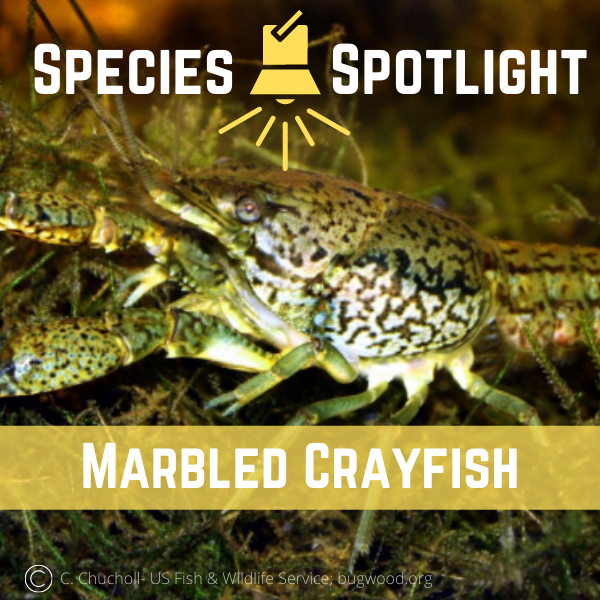This article was featured in the 2022 Winter Newsletter by Paul Hetzler-Former CCE Educator and SLELO Partner.
Sometime in the 1990s, a mutant crayfish able to conquer and degrade aquatic systems emerged. The marmorkreb, a.k.a. marbled crayfish (Procambarus virginalis), is a destructive new species that was first identified in aquariums in Germany. However, their mutation is likely the result of too much inbreeding in captivity, rather than some mad-scientist scheme. They now here, and your help scouting for them is invaluable.
Marmorkrebs are mid- to large sized, from 10 to 15 cm (4-6 inches). Typically, they are olive to dark brown, but infrequently appear reddish, blue or tan just to throw us off. Also, their claws are narrow, with tinier pincers than those of native crayfish.
Marbled crayfish have a high fecundity, a female can lay around 700 viable eggs at a time without the hassle of finding a mate. All her offspring are females, which soon mature and begin cloning themselves. This talent, known as parthenogenesis, is occasionally seen in insect species but seldom in larger organisms. Being parthenogenic also means that a lone individual can beget her own crustacean kingdom.
They are generalists, thriving in a wide range of habitats from lakes to rivers to marshes and mud puddles. Fast-moving water does not seem to be a problem for them. They’re cold-hardy but love the heat, too. Not surprisingly, marmorkrebs eat a host of aquatic life including algae, plants, amphibians, and snails. They burrow into banks, which raises turbidity, releases nutrients from sediments into the water, and accelerates erosion.
Because marbled crayfish are seen as a food source in various regions, they are sometimes deliberately spread, and they are sold on the web and even in some pet stores in the US. While marmorkrebs are known to be widespread here in the pet trade, at the moment there are no reports of wild populations in New York State. This is where public outreach and citizen science come in.
The invaders are dispersed when poorly informed aquarium owners release excess crayfish from their tanks into surface waters, and when anglers use them as bait. To help keep the marbled crayfish from invading natural areas it’s important to not use them as bait, and never to dump unused bait or unwanted aquarium pets into waterways.
Report possible sightings of marbled crayfish or other invasive species to iMapInvasives, or save a specimen and contact our Aquatic Restoration and Resiliency Coordinator, Brittney Rogers at Brittney.Rogers@tnc.org .
Paul Hetzler is a former educator with the St. Lawrence County Cornell Cooperative Extension, and SLELO partner. He is known for his humorous writings about nature. Check out more articles about invasive species and nature on his website Where the Wild Words Are.


